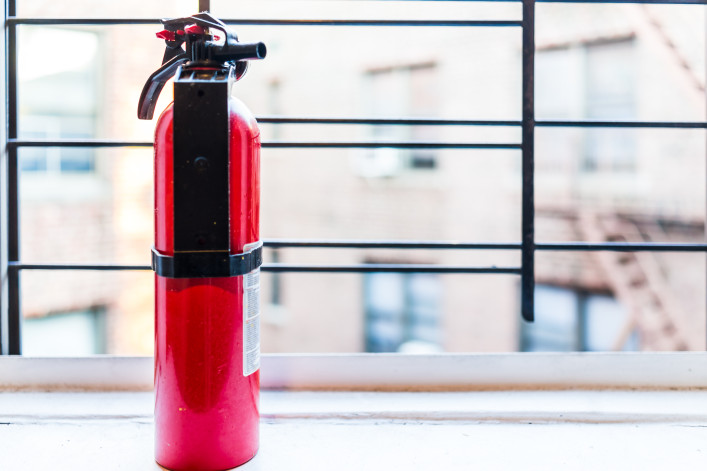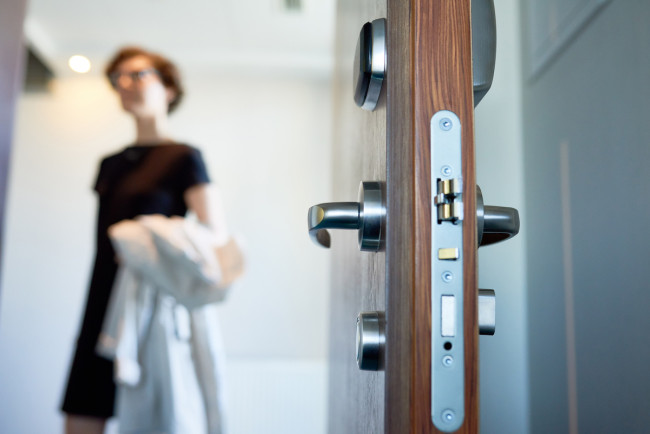Learn to use a fire extinguisher, block home invasions, and other tips to stay safe in your NYC apartment

Most people don't have a clue how to use a fire extinguisher, says Robert O’Brien, co-owner of NY Fire Consultants and a former FDNY firefighter.
iStock
How well do you know how to keep yourself safe in your New York City apartment? Fires and break-ins do happen, and safety experts recommend being proactive against these dangers.
Robert O’Brien, co-owner of NY Fire Consultants and a former FDNY firefighter, says it’s the simplest things that cause the worst tragedies, like overloaded extension cords or not changing the batteries in your apartment’s smoke and carbon monoxide detectors.
Among his safety recommendations, he suggests learning how to use a fire extinguisher, having some simple tools on hand to defend yourself against break-ins, and having a ‘go-bag’ ready if you need to leave the apartment in an emergency.
How to use a fire extinguisher
A fire extinguisher is a common household item, but do you actually know how to use one, especially when you are under pressure?
“Most people haven’t got a clue,” says O’Brien. To use them correctly, remember the acronym PASS: Pull the pin, aim, squeeze the handle, and use a sweeping motion at the base of the fire. These instructions are also on the base of your fire extinguisher if you need to refresh your memory.
O’Brien suggests taking it one step further. “Find some kind of training, ideally something hands-on, or stop in at your local firehouse, and talk to your local firefighters. Tell them you want to talk to your family about training,” he says.
Have simple tools on hand
Last winter O’Brien gave his family rubber door stoppers as gifts—to keep them safe from intruders. It was a tip he learned from active shooter training he did with U.S. Navy Seals.
“There’s a lot of people who might not be able to move a file cabinet or desk in front of a door to block it. This little rubber stopper? Kick it under the door and someone on the other side can’t push it open,” he says.
Simple tools you have around the house can be repurposed to keep you safe, says O'Brien. Take a hammer for example—in a break-in situation, the claw end of the hammer can be used to grab an intruder’s weapon. Not only that, but you can use it as a tool to claw through a sheetrock wall to gain access to another room, or break a window and get out of the building in an emergency. You could also use a hammer to bang that little stopper firmly under the door.
Know how to block smoke
Another reminder from Security consultant Allan Schwartz is to use wet towels at the base of a door if there's a fire on the other side of it.
"It prevents the smoke from coming through the door and gives you time to use the fire escapes as quickly as you can and call 911," he says.
Keep fire safety equipment up-to-date
Did you switch out the batteries in your smoke detector when the clocks changed? Fire safety experts recommend this as the best way to make sure the unit functions year-round.
Be careful with extension cords
Extension cords in older apartments can be a fire hazard, especially if two cords are connected or overloaded.
"It's called piggybacking and it's the cause of numerous fires in the city," says O'Brien. Likewise, don't tuck cords under a rug. "You're putting a flammable load over an extension cord," he says, and that can start a fire.
Have a safety plan
Your building should have a safety manual or guidebook that addresses any threats to residents like trespassing, vandalism, burglary, or fire. Schwartz says the manual will outline evacuation procedures. He also points out you should never get in an elevator if there's a fire.
"A good emergency practice is to recall the elevators to the first floor in a fire, so nobody gets in and gets trapped," he says.
O’Brien has written lots of evacuation plans for families in NYC, particularly those who live Uptown. He recommends practicing at-home fire drills, having a secure area to meet outside the apartment, and have a ‘go-bag’ ready with cash, medicines, and copies of your ID if you need to leave the apartment quickly.
You Might Also Like


























